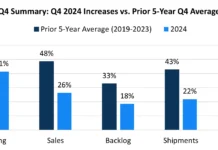by Dr. Andreas Reger, researcher

All businesses face threats of decline, but none is as great as the threat posed by an economic recession. According to the National Bureau for Economic Research (NBER), the US economy has experienced 11 recessions since 1945 and business failures are disproportionately concentrated during such recessions. Because of the financial crisis of 2007-2009, the number of company bankruptcies in the US surged from a low of 20,000 in 2007 to 60,000 in 2010 (see Graph 1).
More than eight years have passed since the financial crisis, and the economy still is expanding. However, the next recession might be just around the corner. The purpose of this article is to help companies to be better prepared for this next – and inevitable economic downturn.
The basis of this article is a research study that investigated the combined financial impact of turnaround strategies pursued by members of the Manufacturers Association of Plastics Processors (MAPP) during and after the financial crisis of 2007-2009. Numerous turnaround strategies are available to companies, and the purpose of the study was to identify the strategies that proved most beneficial for small and medium-sized plastics processors.

The study classified these strategies into two major groups: a) efficiency strategies, and b) entrepreneurial strategies. Efficiency strategies are more internally focused and include financial and operational measures. Entrepreneurial strategies are more externally focused and include customer, product and market measures. As shown in Graph 2, this study researched 20 measures that were available to the participants.
Information was collected with the support of Plante Moran, which surveyed senior leaders (mostly the CEO and/or CFO) of MAPP member companies and provided the anonymous financial data of these companies for the years 2007 through 2013. The participants were asked to estimate the level of intensity to which they applied these 20 financial, strategic and operational measures. The application of these measures then was correlated with the financial performance of the companies throughout and after the crisis.
The study yielded several significant findings of which the following are most pertinent to small and medium-sized plastics processors:
1. Company size matters
Although both large and small businesses suffered from the same external circumstances, their strategies varied greatly. One of the most remarkable findings is the unlikely impact a change in product pricing had on these companies. As one would expect, the financial performance of smaller companies was very positively impacted by any increase in product pricing that was implemented in the 2007-2010 timeframe.

At the same time, the financial performance of larger companies (greater than $100 million in annual revenues) seemed to benefit even more from a small decrease in pricing. Graph 3 shows that the financial performance of companies under $5 million (solid blue line) improved considerably for every one percent price increase, while a price increase was less beneficial for larger companies.
Although this seems highly counterintuitive, there is a logical explanation for this effect. During the retrenchment phase of the financial crisis, customers were looking for strong and financially healthy suppliers that could ensure uninterrupted supply of product. This benefitted the larger companies that were financially stable and allowed them to take on transfer business from smaller competitors. Although they might have had to offer a slight price decrease, the overall increase in volume helped them to increase their market share and cover their fixed costs. Any price decrease also greatly limited the risk of being replaced by a competitor. Once the recovery set in, these companies had consolidated the market and reaped the benefits of increase volume production and reduced competition.
2. Company financial health1 matters
Financially strong (i.e. Altman Z-score greater than 2.9) and well-capitalized companies (i.e. sufficient cash flow was generated to cover working capital requirements) did not have to implement any turnaround strategies to survive the recession. The implementation of efficiency strategies (i.e. financial and operational measures) had almost no measurable impact on their financial performance.

On the other hand, financially weaker companies (i.e. Altman Z’-score less than 2.9), benefitted greatly from the implementation of efficiency strategies. Applying multiple linear regression analysis, we found a direct and positive relationship between the number of efficiency strategies implemented and the financial performance of these companies. As Graph 4 shows, companies that applied all eight efficiency strategies improved their Altman Z’-score by more than one point from 2007 to 2010.
Forty percent of the study participants had an Altman Z’-score of less than 2.9, and the turnaround strategies that most positively impacted the performance of these companies during the 2007-2010 timeframe were as follows:
- piece price increases (particularly for smaller companies),
- inventory reductions,
- headcount reductions,
- skilled headcount redeployment,
- capital spending reductions and
- an increase in accounts payables.
3. Speed matters
Companies that waited too long to act suffered deeper declines than companies that took quick and decisive action at the beginning of the downturn. Companies that had not prepared for the downturn and started thinking about turnaround strategies only once the economy tanked took considerably longer to recover from the recession than companies that were well prepared and had developed a “playbook” with strategic options that they then could implement quickly.
4. Timing matters
All turnarounds, whether caused by external (e.g. recession) or internal (e.g. operational and strategic) issues, encompass two stages – the initial retrenchment stage (decline in economic activity) and the subsequent recovery stage (increase in economic activity)2.

These two stages require different strategies. Graph 5 shows that the same strategies that helped financially weaker companies during the retrenchment stage (i.e. there was a positive correlation with financial performance) became detrimental and damaging during the recovery stage (the correlation turned negative).
During the recovery phase, Value Analysis Value Engineering (VAVE) and new product development proved to be most successful for both financially stronger and weaker companies.
Lesson Learned: Successful turnarounds depended on a combination of financial, strategic and operational improvements.
To secure financing (i.e. liquidity) is a crucial first step in a turnaround situation! However, as financial results are the outcome of strategic choices and operational performance, it is important to correctly assess the original cause of decline to apply the appropriate strategic and operational countermeasures. A focus on financial ratios alone might lead companies into a succession of bankruptcies (e.g. Aloha Airlines, Bally, etc.).
Be prepared and develop a “playbook”
Identify, assess and develop the strategic options that are available before the next recession hits. Develop a playbook as the manual to survive and prosper during the next crisis. Preparation is half the battle. Don’t be surprised, be prepared.
Deploy “pre-crisis” strategies

Take action today while time, resources and leverage to do so are available. Graph 6 shows some examples of strategic actions that should be considered. The appropriateness and benefits of each of these measures vary among companies, and a more thorough analysis of each particular situation would have to be conducted to assess their applicability.
Conclusion
This is the first study that analyzed turnaround strategies for a wide variety of privately-held, US-based plastics processing companies. While no two companies are 100 percent the same, the findings of the study are widely applicable, as the participants represented a sample of the plastics processing industry in the US.
In addition, even though this study focused on an external event (i.e. recession), the findings also apply to turnaround situations that are caused by internal issues, such as operational inefficiencies and poor strategic choices.
The most successful businesses have always had a more expansive view by comparing a firm’s performance to the performance of other companies in the industry or the economy. Therefore, the need for turnaround also might arise as a consequence of a company’s substandard performance. Recognizing the signs and admitting a firm’s decline is a crucial first step for management to initiate corrective actions, which need to be implemented as quickly as possible before problems become too severe.
Companies can and should proactively prepare for the next downturn. Among other factors, company size and financial strength influence the choice of strategy, as well as its effectiveness and benefits.
The same strategy that works for a financially strong company might be fatal for a financially weak one, and small companies cannot just copy the playbook of larger companies. There are significant differences between companies that need to be considered and analyzed. A thorough analysis of internal operations and the external / competitive environment is required.
Benchmarking information such as Plante Moran’s North American Plastics Industry Study can provide valuable financial and competitive benchmarking data. Knowing where a company stands compared to its peers helps to identify areas of improvement before they become a major issue. Once the root causes of underperformance are identified, the appropriate strategic and operational countermeasures can be applied.
The author would like to thank Plante Moran and Jeff Mengel for the invaluable support that made this study possible. Dr. Andreas Reger has spent his whole career focusing on growth, turnaround and performance management in an international business environment. His professional experience includes P&L responsible leadership positions at Siemens, Continental and Dürr, as well as privately held plastics processors. Dr. Reger studied International Business Management in Germany and Spain, obtained his Master of Business Administration degree from Colorado State University and received his Doctorate in Business Administration from Lawrence Tech in Southfield, Michigan, where he researched the impact of turnaround strategies on financial performance of small and mid-sized manufacturing companies.
More information: areger@ltu.edu
References
- Financial Health was measured by the Altman Z’ score, which is a predictor of the potential for bankruptcy in privately-held industrial companies.
- For the purpose of this study, we used annual US Gross Domestic Product (GDP) growth rates to define these stages. Based on real GDP, the 2007-2009 period was considered the retrenchment stage and the 2010-2012 period the recovery stage.




